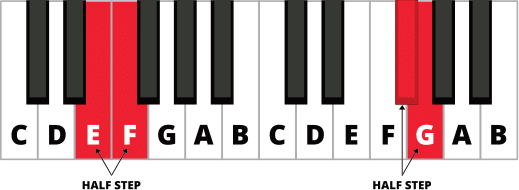Can you play a C major chord?
Probably.
How about a G# major?
Db minor?
You might be able to work it out, but I’m going to show you how to play a major or minor chord in root position on ANY note on the piano.
Yes … even G#.
How?
This is a super simple, easy-to-remember formula that you can learn in seconds and start playing right away. We’re going to keep all our chords in root position today to make things easy and to keep the formula the same for any note on the piano.
The first thing you need to do is pick a note.
Any note…

That’s the root note. We’re going to build a major and minor chord on top of it.
Before we build a major or minor triad (which is a fancy name for a chord with 3 notes stacked on top of each other), it helps to build the outer “shell”.
This is where the first part of the chord formula applies.
From your root note (the one you chose, remember), count up 7 HALF-STEPS.
A half-step is the shortest distance between two notes on the piano. For most of the notes, it will be the distance from a white key to a black key, or vice-versa.
Here are what half-steps look like on the piano:

Super short, right?!
So — count up 7 half-steps from the root note. For example, if you picked C, then counting up 7 half-steps would get you to G.
If you started on G#, then counting up 7 half-steps would get you to D#.
It works on ANY note on the keyboard. Try it.
So now we have the outer shell, it’s time to fill it in.

Understanding how chords work will give you a BIG leg up in learning how to play the piano. Knowing just a handful of chords will unlock hundreds, if not thousands of pop songs. To get started today, check out our free Chord Hacks course, or read How to Play Piano Chords.
This is the fun part! This is the part where we decide whether the chord is going to be major or minor.
Let’s start with a major chord.
From the root note, count up 4 half-steps. That note is called the third and it’s what makes the chord a major chord.
So let’s go back to the formula. We started on the root note (1) and then we count up 4 half-steps to get the middle note (4) and 7 half-steps to get the top note (7).
That means the chord formula for a MAJOR triad is:
1 – 4 – 7
And it works on EVERY. SINGLE. NOTE.
Now let’s look at a minor chord. It’s very similar to the major chord, but the middle note is one half-step LOWER than a major chord.
So what’s the formula?
Well, if the major formula is 1 – 4 – 7 and the minor chord has its middle note one half-step lower, then it will be:
(I know you know)
1 – 3 – 7
Notice how different the chord sounds just by changing that ONE note? Now it’s called a minor third, instead of a major third.
I feel like I’ve said this a lot already, but you can try this on ANY note on the piano.
So go practice building major and minor chords using the formula. The more you do it the faster you’ll get. Soon you won’t even have to use the formula — but it’s a great way to get comfortable and to start playing chords.
And when you play them, try to really LISTEN to the difference between the major chords and minor chords. It will help train your ear so you’ll be able to hear and play music more easily.
But I’m going to be honest…
Playing only major and minor chords can get boring pretty quickly.
Instead of just playing the chords, try breaking them up and playing the notes separately. So you’d play the bottom – middle – top – middle and repeat.
Do it for both major and minor chords, and move around the piano starting on different notes.
This will make the practice sound a lot more musical while also helping you get comfortable playing all sorts of different chords.
And once you get comfortable with triads, you can start using them to create your own chord progression, harmonies, and music.
Have fun!
Lisa Witt has been teaching piano for more than 20 years and in that time has helped hundreds of students learn to play the songs they love. Lisa received classical piano training through the Royal Conservatory of Music, but she has since embraced popular music and playing by ear in order to accompany herself and others. Learn more about Lisa.


By signing up you’ll also receive our ongoing free lessons and special offers. Don’t worry, we value your privacy and you can unsubscribe at any time.
We use cookies for traffic data and advertising. Cookie Policy »